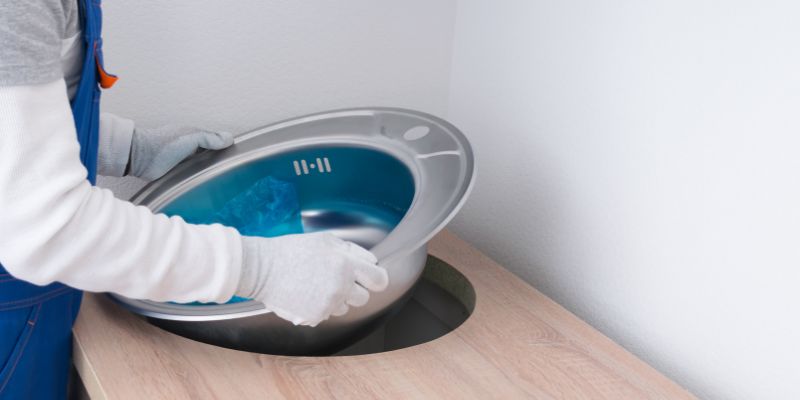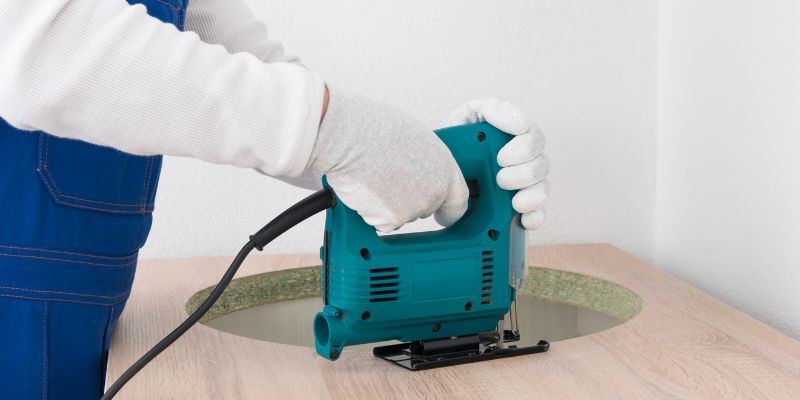To cut a hole for a sink in a countertop, measure and mark the desired location. Use a jigsaw to carefully cut along the marked lines, ensuring accuracy and precision.
After cutting the hole, test the fit of the sink before securing it in place. Cutting a hole for a sink in a countertop can be a straightforward process if done correctly. Whether you’re installing a new sink or replacing an old one, precision is key to ensure a proper fit.
We will walk you through the step-by-step process of cutting a hole for a sink in a countertop, helping you achieve a seamless and professional-looking installation. From measuring and marking the location to using the right tools for cutting, we’ll provide you with valuable tips and guidance. So, let’s get started and learn how to cut a hole for a sink in a countertop flawlessly.
Choosing The Right Tools
Cutting a hole for a sink in your countertop requires careful planning and the use of the right tools. Selecting the appropriate tools is crucial to ensuring a smooth and precise cut, while also minimizing any potential damage to your countertop. In this section, we will discuss the essential tools needed for this task.
Selecting The Appropriate Saw
When it comes to cutting a hole in a countertop for a sink, using the right saw is essential. A jigsaw or a hole saw is the most commonly used tool for this purpose. A jigsaw offers versatility, allowing you to make curved or straight cuts depending on your sink design and countertop material.

Gathering Other Essential Tools
Aside from the saw, there are a few other tools you’ll need to complete this task successfully. Here is a list of the essential tools:
Measuring Tape:
Before you begin cutting, it’s crucial to measure the dimensions of your sink carefully. This will help you determine the correct size and position for the hole.
Pencil:
Marking the outline of the hole on your countertop is essential for ensuring accuracy. Using a pencil allows you to easily erase and make adjustments if needed.
Using masking tape along the marked lines can help prevent any potential chipping or splintering when cutting the hole. It acts as a protective barrier, ensuring a clean and smooth cut.
A clamp is necessary to secure the countertop in place while you cut the hole. This provides stability and reduces the risk of any unwanted movement or slips during the cutting process.
If you’re using a hole saw, you’ll need a drill to create a pilot hole. The pilot hole allows the hole saw to start cutting smoothly without damaging the countertop.
Don’t forget to prioritize safety! Wear protective goggles to shield your eyes from any flying debris, and gloves to protect your hands from sharp edges and potential injuries.
By selecting the appropriate saw and gathering the necessary tools, you’ll be well-prepared to cut a hole for your sink in your countertop.
Measuring And Marking
One of the most important steps in cutting a hole for a sink in your countertop is accurately measuring and marking the area. This step sets the foundation for a successful installation, ensuring that your sink fits perfectly and functions flawlessly. Taking accurate measurements and marking the cutting lines correctly are key to achieving the desired results. Follow the steps below to effectively measure and mark your countertop for a sink installation.
Taking Accurate Measurements
Before you grab your tools and start cutting, it’s crucial to take precise measurements of the sink. This will ensure that the hole you cut is the right size and shape to accommodate the sink properly. Follow these steps:
- Place your sink upside down on the countertop and align it in the desired position.
- Use a measuring tape to measure the length, width, and depth of the sink. Pay attention to any protruding features, such as the rim or flanges.
- Transfer these measurements onto the countertop using a pencil or a marker. Start by marking the corners of the sink, ensuring they are aligned with the outer edges of the sink.
- Measure and mark the distance from the sink’s edge to any other objects on the countertop, such as walls or other appliances. This will help you determine the exact position of the sink.
- Double-check your measurements to make sure they are accurate. Remember, precision is key in this step.
Marking The Cutting Lines
Once you have your measurements, it’s time to mark the cutting lines on the countertop. This step will guide your cuts and ensure that the sink fits perfectly in the designated area. Follow these steps:
- Using a straightedge or a ruler, draw the cutting lines within the marked dimensions on the countertop. Take your time to make sure the lines are straight and aligned with the measurements.
- Double-check the alignment and measurements one more time before proceeding with the actual cutting. It’s always better to be safe than sorry.
- If your countertop is made of a material that can chip or crack easily, consider using masking tape along the cutting lines. This will help prevent any unwanted damage during the cutting process.
By taking accurate measurements and marking the cutting lines correctly, you are setting yourself up for success when cutting a hole for a sink in your countertop. These steps are essential to ensure a seamless installation, with a properly sized and positioned sink that enhances both the functionality and aesthetics of your kitchen or bathroom.
Securing The Countertop
Properly securing the countertop during the process of cutting a hole for the sink is crucial to ensure a precise and safe outcome. Without proper stability, there is a risk of the countertop shifting or slipping, which could result in uneven cuts or damage to the surface. Therefore, using clamps for stability and ensuring the protection of the countertop surface are essential steps in this process.
Using Clamps For Stability
When cutting the hole for the sink in the countertop, use clamps to secure the countertop firmly in place. This will help to prevent any unnecessary movement or shifting during the cutting process, ensuring accuracy and safety. Position the clamps strategically to provide even pressure and stability across the entire surface of the countertop.
Protecting The Countertop Surface
Before securing the clamps, it’s important to protect the surface of the countertop to avoid any potential damage. Place a layer of protective material, such as cardboard or scrap wood, between the clamps and the countertop surface. This will create a buffer and prevent the clamps from leaving any marks or indentations on the countertop while providing the necessary stability.
Making The Cut
Learn the step-by-step process of cutting a hole for a sink in a countertop. Discover the tools and techniques required, and gain expert insights on how to achieve a precise and professional result. Master the art of seamlessly integrating a sink into your countertop with this comprehensive guide.
Using The Correct Sawing Technique
When it comes to cutting a hole for a sink in a countertop, using the correct sawing technique is crucial. The type of saw you use will depend on the material of your countertop. For example, if you have a laminate countertop, a jigsaw with a fine-toothed blade works best. However, if you have a stone or granite countertop, a diamond blade on a circular saw is more appropriate. Always follow the manufacturer’s instructions for using the saw safely.
Avoiding Common Mistakes
Avoiding common mistakes when cutting a hole for a sink can save you time, effort, and potential damage to your countertop. One mistake to avoid is rushing the process. Take your time and measure twice before making any cuts. Another mistake to watch out for is not using a drilling template. A drilling template ensures that the hole is accurately placed and that the edges are smooth. Additionally, make sure to wear the appropriate safety gear, such as goggles and gloves, to protect yourself during the cutting process.
| Mistakes to Avoid | Tips to Prevent |
|---|---|
| Cutting too quickly without proper measurements | Measure twice before making any cuts |
| Not using a drilling template | Use a drilling template for accurate placement and smooth edges |
| Not wearing safety gear | Wear goggles and gloves to protect yourself |
- Measure twice before making any cuts
- Use a drilling template for accurate placement and smooth edges
- Wear goggles and gloves to protect yourself
Remember, it’s important to exercise caution and patience when making the cut for your sink. By using the correct sawing technique and avoiding common mistakes, you can ensure a precise and successful installation. Take your time, follow the guidelines, and enjoy the satisfaction of a job well done.
Finishing Touches
Cutting a hole for a sink in a countertop requires careful precision. Learn the essential steps to achieve a seamless finish without any hassle.
As you near the end of your countertop installation project, it’s time to focus on the finishing touches. This is where you’ll complete the final steps to ensure that your sinkhole is smooth, polished, and ready for the sink to be installed. In this section, we’ll cover two important steps: smoothing the edges and correctly installing the sink.
Smoothing The Edges
To achieve a professional look, it’s crucial to have smooth edges around the sinkhole. Follow these simple steps to ensure your countertop is properly finished:
- Start by using a belt sander with fine-grit sandpaper to eliminate any rough edges around the hole. Remember to follow the manufacturer’s instructions for safe operation.
- Next, switch to a random orbital sander with a higher grit sandpaper to further smooth the edges. Take your time and work in a circular motion to achieve an even finish.
- Use a wet sponge to wipe away any dust and debris, ensuring the edges are clean and ready for the next step.
- Finally, apply a countertop sealer to protect the edges from moisture and prevent any future damage. Allow the sealer to dry completely before proceeding to the next step.
Installing The Sink
Now that the edges are smooth, it’s time to properly install the sink. Follow these steps to ensure a secure and leak-free installation:
- Apply a thin bead of silicone caulk around the edges of the sink cutout on the countertop.
- Carefully lower the sink into the cutout, ensuring it fits snugly. Double-check the alignment and make any necessary adjustments.
- Connect the sink to the plumbing using the appropriate connectors and fittings, following the manufacturer’s instructions.
- Tighten all connections and check for any leaks. If you notice any leaks, tighten the connections further or consult a professional if needed.

Frequently Asked Questions For How To Cut Hole For Sink In Countertop
What Tool Do You Use To Cut A Sink Hole In A Countertop?
To cut a sinkhole in a countertop, use a router with a template or a jigsaw with a plunge-cutting blade. Ensure to measure and mark the hole accurately before cutting.
How Do You Cut A Hole In A Sink In Formica Countertop?
To cut a hole in a Formica countertop sink, use a jigsaw with a fine-tooth blade. Mark the outline of the hole and drill starter holes in each corner before cutting along the lines with the jigsaw. Sand the edges to smoothen them.
How Do You Cut A Countertop Without Chipping It?
To cut a countertop without chipping it, follow these steps:
1. Use a sharp, fine-toothed saw blade appropriate for the countertop material.
2. Apply masking tape along the cutting line to reduce chipping.
3. Cut slowly and steadily, allowing the blade to do the work.
4. Support the countertop securely to prevent vibrations.
5. Avoid applying excessive force or rushing the process.
How Do You Drill A Hole In Laminate Countertops?
To drill a hole in laminate countertops, follow these steps:
1. Mark the desired location for the hole.
2. Secure the countertop to prevent slipping.
3. Use a drill with a carbide-tipped bit.
4. Apply steady pressure while drilling at a slow speed.
5. Clean the area and remove any debris.
Conclusion
Cutting a hole for a sink in a countertop is a manageable DIY task with the right tools and guidance. With careful planning and attention to detail, anyone can achieve professional results. Following the steps outlined in this guide will ensure a successful outcome and a beautiful new addition to your kitchen or bathroom.

